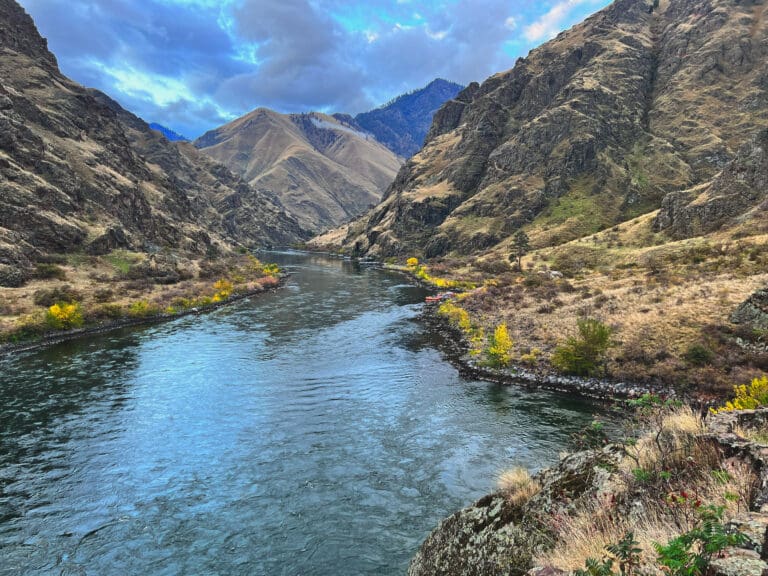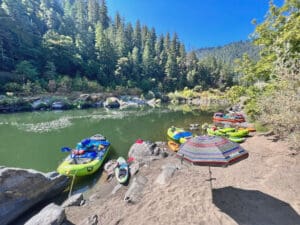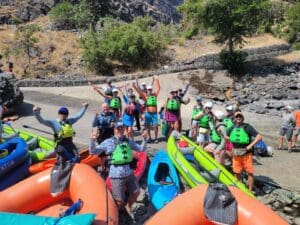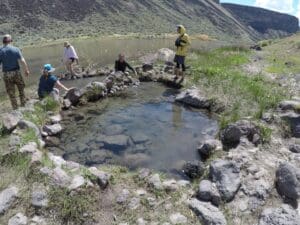The Snake River threads its way through the heart of the American West—flowing over 1,000 miles through rugged wilderness, high mountain valleys, arid cliffs, and fertile plains. It’s more than a river: it’s a dynamic blend of geology, history, ecology, culture, and adrenaline. Running through Wyoming, Idaho, Oregon, and Washington, the Snake River is one of the most iconic waterways, offering every type of traveler something to fall in love with.
Whether you’re looking to conquer whitewater rapids or a nature lover seeking serene moments with wildlife, the Snake River delivers. From the high mountain valleys of Wyoming to the wild gorges of Idaho and the wine country of Washington, here are 9 unforgettable things to do on the Snake River—with rafting in Hells Canyon topping the list.
1. Whitewater Rafting Through Hells Canyon (Idaho/Oregon)
If there’s one bucket-list adventure you must experience on the Snake River, it’s whitewater rafting through Hells Canyon—North American’s deepest river gorge. Straddling the border of Idaho and Oregon, Hells Canyon plunges to depths of nearly 8,000 feet, offering some of the most dramatic scenery and heart-pounding rapids in the U.S.
What Makes It Epic?
Imagine launching your raft early in the morning, the canyon walls towering on either side being touched by dawn’s glow. You’ll paddle through thunderous Class III rapids—that will leave your heart pounding, while calmer stretches give you a breath. Between rapids, you’ll float past dramatic cliffs, hidden side streams, and ancient rock faces.
Rafting trips range from single-day outings to multi-day expeditions (typically 3-6 days) where you’ll camp riverside under the stars. Evenings are spent around campfires, swapping stories, listening to the hiss of rapids, and watching silence settle over the canyon. Guides often hike you to hidden ancient petroglyphs and historic homesteads, weaving history into the experience.
Who Is It For?
- Adrenaline seekers: Those who thrive on splashy rapids and rugged scenery.
- Adventurers: River lovers looking to unplug, hike remote trails, and sleep outdoors.
- Photographers: Every bend reveals a new spectacle—dramatic light on canyon walls, reflections, wildlife like bighorn sheep, osprey, or even black bears.
When to Go?
The prime rafting season typically runs from May through September. Early summer brings higher water and more intense rapids; by mid-summer, flows mellow, making the float sections more relaxing. Shoulder season offers a peaceful trip with less crowding, though some rapids may be tamer.
Pro Tips
- Pack quick-dry clothing, layers, sun protection (hat, SPF, sunglasses)
- Bring water sandals or secure footwear, not flip-flops
- A waterproof camera or GoPro helps capture memories—and dry bags protect your gear
- Book early, especially for summer weekends—they fill up fast
Recommended Outfitter, us of course! —Tributary Whitewater.
This is a true wilderness experience—off the grid, surrounded by rugged canyon walls, and serenaded by the rush of whitewater. If you do just one thing on the Snake River, make it this.
Explore more adventures on the Snake River.
2. Scenic Jet Boat Tours in Hells Canyon
Not a fan of paddling through rapids? No problem. You can still experience the raw beauty of the terrain via a jet boat tour—offering a thrilling but more comfortable way to explore Hells Canyon. These high-powered boats zip you upriver, slicing through waves while offering informative commentary and stops at scenic vistas and historical landmarks.
A More Relaxed Rush
Unlike rafting, where you paddle and steer, just boat tours let a professional driver navigate. You hold on tight as you zip past towering basalt cliffs, weave through rapids, and visit hidden coves. While you don’t paddle, the rush of speed and spray against the canyon walls delivers its own thrill.
What You’ll See
- Historic relics: abandoned cabins, relic mining tools, and homesteads
- Cultural sites: Native American petroglyph panels that whisper ancient stories
- Wildlife: Keep an eye out for bighorn sheep perched on rocky outcroppings, bald eagles circling above, and maybe a black bear sipping water.
Jet boat tours are perfect for:
- Families with younger kids who still want adventure
- Photography lovers seeking easily accessible vantage points
- Those short on time—full-day and half-day tours are available, often from launch points like Pittsburg Landing or Hells Canyon Dam
Logistics & Tips
- Bring layers—you might get wet and temps in the canyon can shift quickly
- Sunshade or a hat helps when skimming under open sky
- Booking in advance is wise, especially during peak season
- Tours often include light refreshments or allow stops for picnics overlooking the river
A jet boat tour strikes the ideal balance between comfort and excitement—giving you the thrill or canyon walls whipping by with none of the paddling. Why not do both? Some of Tributary’s Rafting trips on the Snake River include a jetboat trip back to the put in point.
3. Fly Fishing on the Snake River (Idaho/Wyoming)
The Snake River is a fly fishing paradise, especially in the upper stretches near Jackson Hole, Wyoming, and eastern Idaho. The river slows to crystalline clarity, coursing through mountain valleys that harbor native Snake River fine-spotted cutthroat trout, as well as brown trout and rainbow trout.
Why Anglers Flock Here
- The water is clear and cold, ideal for trout
- Trout populations are healthy, especially in remote stretches
- The landscape is stunning—pine-fringed riverbanks, reflection-filled pools, and Teton views
Popular Spots:
- South Fork of the Snake River (near Swan Valley, ID)—known for solitude and rising trout
- Henry’s Fork—meanders through meadows and riffles, perfect for dry-fly fishing
- Jackson Hole region—closer to town, easy access and scenic launch points
For Every Skill Level
- Beginners can take guided float trips—relaxed and supportive with gear and instruction provided
- Experienced anglers can hone nymphing, dry-fly, and streamer techniques in technical runs
Gear & Guides
- Many guides offer all-inclusive packages: waders, rods, flies, instruction
- Bring polarized sunglasses to spot fish, and layer for chilly mornings
Why It’s Loveable
Few things match drifting a fly with the river’s current, glimpsing the flash of a hooked fish, and pausing to inhale mountain air. Whether you’re chasing the perfect brown trout or enjoying serenity, fly fishing here is therapeutic.
4. Kayaking and Paddleboarding Near Jackson Hole
For a more tranquil experience on the Snake River, head to the Jackson Hole area in Wyoming and swap rapids for reflection. The upper stretches of the Snake here flows more gently, offering scenic floats ideal for kayaking or stand-up paddleboarding—with dramatic mountain backdrops and abundant wildlife.
Launch Spots & Ambiance
- Wilson Bridge to South Park Bridge offers a scenic, calm paddle through willow-lined banks.
- Grand Teton National Park entrances let you float along while gazing at the Tetons painting the skyline.
Wildlife Encounters
- Moose graze along the river edges, craning nostrils into the water.
- Bald eagles perch overhead; their calls echo through the clear air.
- Otters slip effortlessly through eddies; sometimes beavers slip in too.
Why It’s Ideal
- Open to all levels—beginner-friendly and peaceful
- Stunning scenery—mountain views and reflections abound
- Flexibility—rentals and guided trips available; ideal for morning or sunset paddles
Practical Tips
- Bring waterproof layers—mountain mornings can be crisp but warm quickly
- Dry bags keep your phone, snacks, and extra layer safe
- Early starts let you beat wind (and the crowds), plus watch wildlife at their most active
Let the river carry you. Paddle until the world feels small, yet wider, calm, and more beautiful all at once.
5. Visit Shoshone Falls – The “Niagara of the West” (Twin Falls, Idaho)
A masterpiece forged by the Snake River, Shoshone Falls near Twin Falls, Idaho, is one of the river’s most dramatic spectacles. Often taller than Niagara Falls (at 212 feet), this waterfall is known as for it’s a dramatic showcase of water meeting rock—and a must-visit even if it’s not directly on the main river flow.
What Makes It Stand Out?
- The falls are spectacularly tall and wide—particularly breathtaking in spring (April-June) when runoff peaks.
- Rainbows often arc through the mist on sunny mornings.
- The surrounding Shoshone Falls Park offers picnic areas, walking tails, and multiple vantage points.
More Than Just a View
- Quiet honeymoon spots to relax nearby.
- Nearby attractions include the Snake River Canyon Rim Trail and Perrine Bridge (see next section).
- Perfect for a half-day stop en route to other Snake River adventures.
Visiting Tips
- Arrive early during peak flows—for misty rainbows and lower crowds.
- Bring snacks or lunch to enjoy in the park.
- Accessible viewing makes it family-friendly year-round.
Standing on the edge of the overlook, listening to the roar and feeling the mist, you’ll understand why someone dubbed Shoshone the “Niagra of the West”—raw beauty shaped by ancient forces.
6. Explore the Snake River Wine Region (Washington)
Beyond waterfalls and rapids, the Snake River is bordered by rolling hills of vineyards. If you’re a wine lover, this region offers a refined complement to outdoor thrills. When you think of wine country, Napa might come to mind—but the Snake River AVA (American Viticultural Area) in southeastern Washington and Idaho is a hidden gem for wine lovers. This region is known for Syrah, Merlot, Riesling, and Chardonnay, with vineyards nestled above the river’s scenic cliffs.
Wine Styles
- The region’s arid desert climate and heated volcanic soils creates a unique flavor profile
- Syrah and Merlot deliver bold reds; Riesling and Chardonnay shine in whites.
- Many wineries practice sustainable or organic methods, reflecting the land’s character.
Must-Visit Wineries:
- Colter’s Creek Winery (Idaho)—known for accessible reds.
- Basalt Cellars (Clarkston, WA)—intimate tasting room with art and local personality.
- Zhoo Zhoo Winery (Caldwell, ID)—modern vibe, creative blends.
Pair With River Beauty
- Philosophize over a glass while gazing at river amphitheaters.
- Combine a wine tasting tour with a morning float or scenic stop.
- Great for couples, foodies, or those craving a chill afternoon after rugged activities.
Visiting Tips
- Call ahead or check online for tasting hours and appointment requirements.
- Bring a wine tote if you plan to bring bottles home.
- Ask about vineyard tours to see where the vines grow—and get a deeper sense of place.
Pair a day of wine tasting with riverfront views or a relaxing float trip for the ultimate chill Snake River experience.
7. Snake River Canyon Rim Trail (Twin Falls, Idaho)
For those who like to stretch legs on land rather than paddle water, the Snake River Canyon Rim Trail—in Twin Falls, Idaho—delivers drama, access, and sweeping views. This smooth, paved multi-use trail traces the canyon’s edge, perfect for walking and biking. Enjoy panoramic views of the Snake River Gorge, with stops at scenic overlooks and parks.
Highlights Along the Way
- Perrine Bridge: Sky-high at over 400 feet, it’s a popular BASE- jumping hotspot—watch those daredevils leap into the canyon!
- Evel Knievel Jump Site: Relive his 1974 Snake River Canyon attempt via historical plaques and views of the launch area.
- Shoshone Falls Overlook: Multiple vantage points offering different perspectives of the canyon and river below.
Great For…
- Families—paved trail, accessible overlooks, and a shaded park near the main trailhead.
- Cyclists—flat, scenic, and extends several miles.
- Photography enthusiasts—light changes constantly; sunrise and sunset are especially photogenic.
Tips for Visitors
- Park near the visitor center or trailhead.
- Bring a sturdy pair of shoes if you plan on exploring off the main trail.
- Pack snacks or a thermos of coffee and watch the sun dance on the canyon walls.
The trail is family-friendly and accessible year-round. This is a great place to walk, pause, and look deep—down at the Snake swirling below and outward to one of Idaho’s most dramatic landscapes.
8. Wildlife Watching in Snake River Birds of Prey National Conservation Area
Just south of Boise, Idaho, lies a hidden gem: the Snake River Birds of Prey National Conservation Area—home to one of the world’s highest concentrations of nesting raptors here on Earth. Here, the Snake River sculpts canyonlands that eagles, hawks, owls, falcons, and more call home. This is a mecca for bird watchers and wildlife photographers.
Species to Spot:
- Peregrine falcons—known for their high-speed dives.
- Golden eagles, red-tailed hawks, owls, and kestrels
- Sometimes, you’ll even catch glimpses of big horn sheep or deer near cliff edges.
Activities
- Drive or hike to various viewing overlooks (e.g., Boise River, Snake River junctions).
- Guided tours—like raptor watching programs—bring you closer with expert knowledge.
- Pleasant self-guided hiking on marked trails near habitats.
When to Go
- Spring through early summer: nesting season—great for observing raptor behavior.
- Mornings and evenings bring the highest wildlife activity.
Make the Most of It
- Bring binoculars or a telephoto lens—you’ll want to watch from a distance.
- Use Field guides or apps to identify species.
- Check the Conservation Area website for access maps and any closures.
Few places let you feel the invisible wingbeat of the wild above you—sleek, fierce birds that rule the skies and canyon echoes.
9. History and Culture at Nez Perce National Historical Park
Lastly, no Snake River journey is complete without understanding its ancient and living cultures—especially those of the Nimiipuu (Nez Perce people), who have lived along the Snake River for thousands of years. Along the Snake River near Lewiston, Idaho, and Clarkston, Washington, you’ll find sites that are part of the Nez Perce National Historical Park.
Sites & Stories
- Sacred fishing areas, where families camped seasonally for thousands of years.
- Shrine sites and oral-history landmarks—where stories of wisdom, survival, and community are etched into the landscape.
- Interpretive exhibits, tribal museums, and storytelling programs provide meaningful context.
What to Expect
- Walking trails with interpretive signs, combining nature with history.
- Living history programs, tribal-led presentations, and art.
- Quiet places to reflect, with views over the river that carried generations.
Why It Matters
Every rapid, bend, and eddy on the Snake River carries the memory of the people who knew its rhythms long before borders and maps. This region invites travelers to slow down, listen, and connect.
Tips for Visitors
- Check museum hours—many parts are free to browse.
- Be respectful—these are living places of significance to trivial members.
- Pair a visit here with a scenic stop or float nearby to balance reflection and recreation.
Combine a visit here with a day of paddling or fishing for a more meaningful connection to the river and its original stewards.
Plan Your Snake River Adventure
The Snake River is a living tapestry—crackling with rapids, tranquil under paddle, crowned by waterfalls, shaded by birds of prey, and steeped in human history. Whether you’re carving through rapids in Hells Canyon, casting for trout in the Tetons, sipping wine above the river valley, or simply soaking in the sunset from a scenic overlook, the Snake River offers a uniquely American adventure—wild, varied, and unforgettable.
Travel Logistics & Tips
- Best Seasons:
- Late spring to Early Summer (May-June): High water for rafting, vibrant wildflowers, peak birding. Expect cooler canyon mornings.
- Mid-Summer (July-August): Comfy weather, calmer water—great for float trips, rafting, kayak/paddleboard, wine tasting, hiking.
- Fall (September-October): Fewer crowds, color-changing foliage, crips air
- Permits & Bookings:
- Some Hells Canyon trips, permits are usually handled by outfitters—but check U.S. Forest Service rules.
- Wineries often ask for appointments.
- Nez Perce sites, trailheads, and birding viewpoints may have seasonal hours—check ahead.
- Getting There:
- Launch from towns like Lewiston-Clarkston, Twin Falls, Jackson Hole, or even Boise.
- Plan lodging: campgrounds, lodges, B&Bs, or riverside outfitters.
- Gear Essentials:
- Layered clothing, sun protection, water shoes.
- Binoculars for birding.
- Fishing gear or paddle gear (rent available).
- Camera or field journal to capture thoughts and sights.
- Balance Activity & Rest:
-
- Pair thrilling days (rafting, jet boat) with calm ones (wine tasting, history).
- Let your itinerary flow—don’t overpack travel days; build in breathing time.
Final Reflections
A journey along the Snake River isn’t simply about the things you do—it’s about connection. The Snake River is more than just a waterway—it’s a living, flowing story of geology, ecology, culture, and recreation. Whether you’re after adrenaline, tranquility, or a bit of both, this river delivers in spades.
So go ahead—raft the wild rapids of Hells Canyon, explore the scenic overlooks, fish the legendary waters, or discover the region’s rich heritage. However you experience it, the Snake River is sure to leave a lasting impression.




